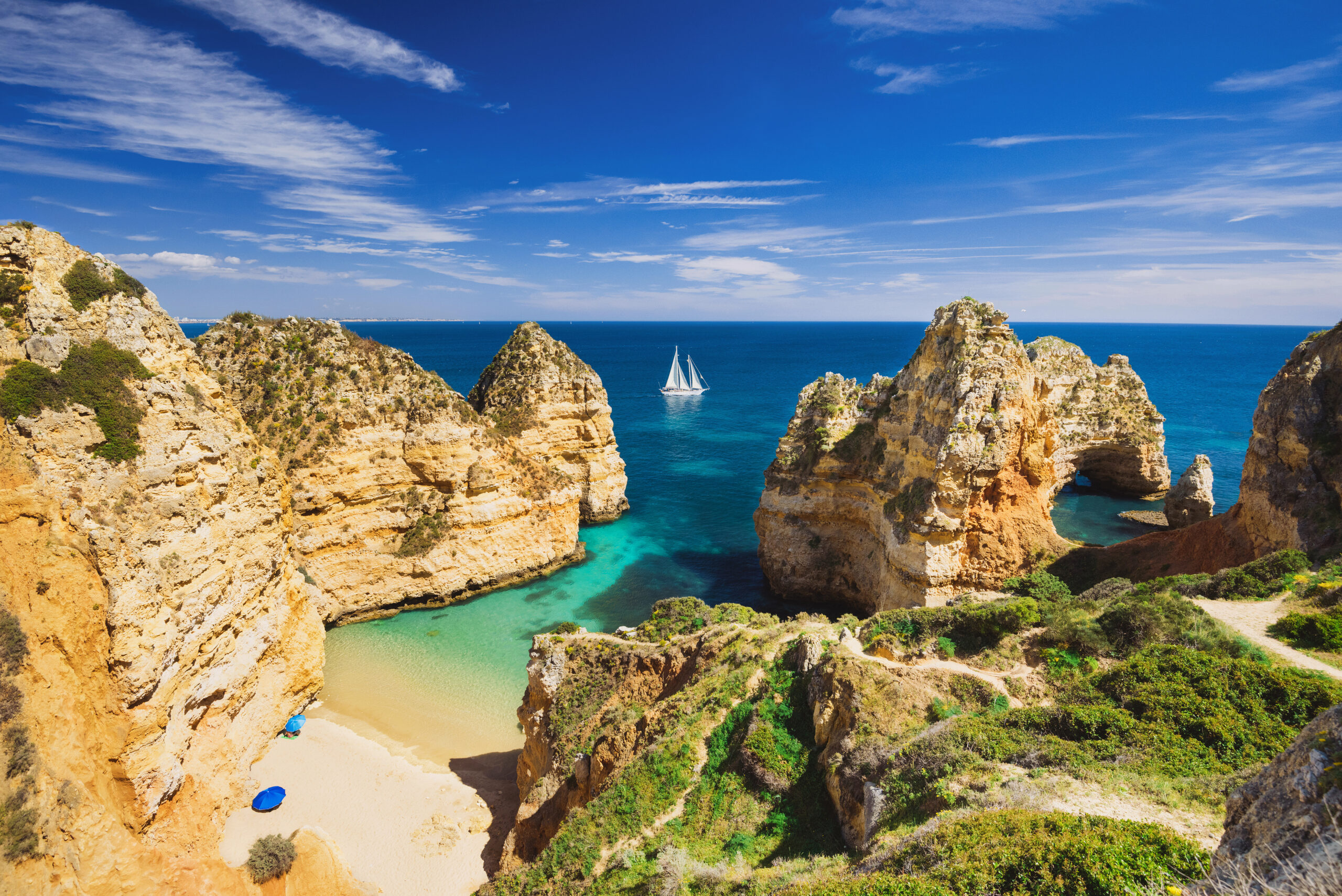Probably the most beautiful and rugged side of Portugal lies in the south of the small country, in the popular destination of the Algarve. With its rugged rocky coasts and fabulous beaches, this dreamlike destination attracts holidaymakers from all over the world who come here to relax by the sea or to see the numerous sights that the Algarve has to offer.
What attracts most Algarve vacationers are certainly the sandy beaches surrounded by towering cliffs. Also known as the Rocky Algarve, this stretch of coastline is unique in Europe and is located in the western Algarve. East of the city of Faro, on the other hand, this varied region is dominated by flatter landscapes with long sandy beaches that are just as inviting for a dip in the refreshing waters of the Mediterranean.
Once you’ve had enough energy by the sea, it’s also worth taking a trip to one of the interesting towns along the coast. The towns of Faro, Tavira and Lagos attract tourists with their pretty old towns and the traditional seafaring town of Sagres – the most south-westerly point in Europe – is always worth a visit on an Algarve vacation.
Faro
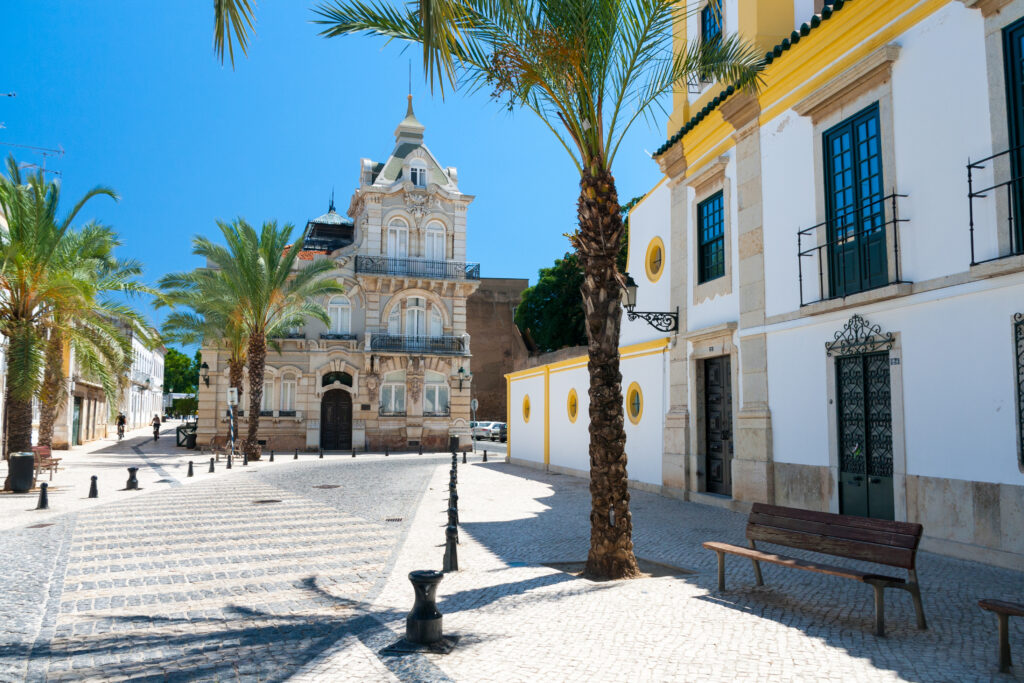
Faro is located in the east of the Algarve, in the part known as the Sandalgarve. From here, all vacation resorts in the region can be reached within an hour by car. It is also only 70 km from Faro to the Spanish border.
Faro itself is not one of the most popular destinations in the region. Most holidaymakers are drawn to Lagos, Portimão, Albufeira and the like.
With around 45,000 inhabitants, Faro is the largest city in the Algarve and has a number of attractions worth seeing. The old town with its cathedral and other historic buildings can be explored on foot. Here you will also still find authentic Portuguese everyday life, which has long since disappeared in most tourist resorts in the Algarve.
Faro is lively and authentic. The city offers everything for a great Algarve vacation. Culture, beaches, nightlife and beautiful nature in the immediate vicinity.
What you should definitely do in Faro: Enjoy a beach day at Praia de Faro, stroll through the pretty old town and take a trip to the Ria Formosa Nature Park.
You can explore the historic buildings in Faro’s old town on foot.
Benagil Cave
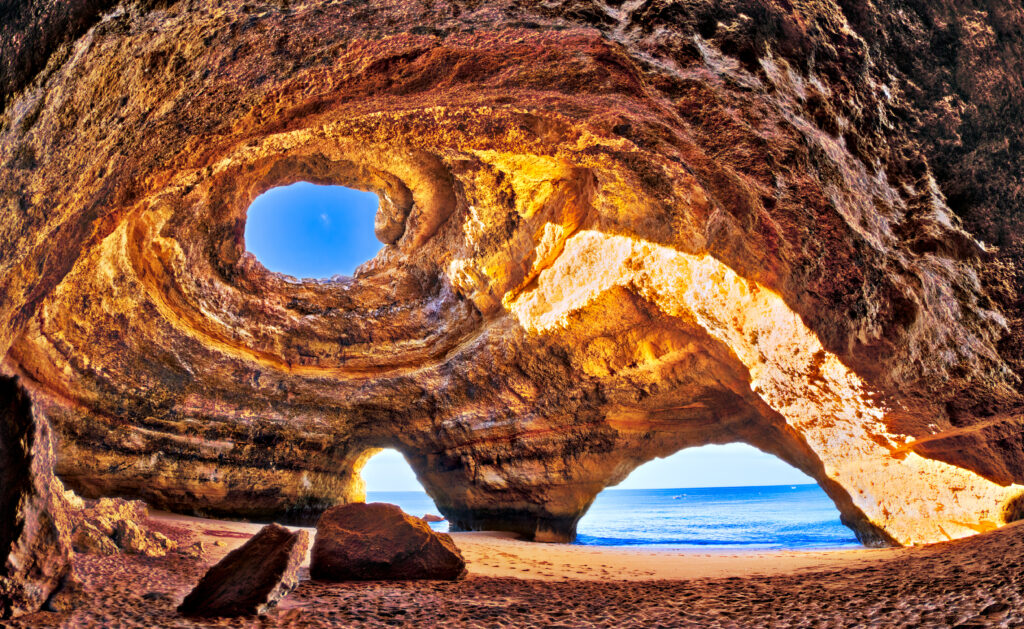
The Benagil Cave in the Algarve is one of the most popular sights in the south of Portugal. It is located directly on the sandy beach of the same name, Praia de Benagil.
The huge rock cave is a real tourist magnet and a beautiful excursion from the surrounding Algarve resorts.
There are various ways to reach the Benagil cave. You can of course take one of the boat tours on offer or you can swim to the cave, hire a kayak or SUP or paddle from the beach to the cave on an air mattress.
The cave is only around 100 m away from Benagil beach. This is no problem for experienced swimmers. If you want to see a bit more of the coast, a kayak is a good choice
You can also walk from the beach to the cave and admire the view from above into the grotto. There is no direct path up from the beach, you have to walk up from the parking lot on the beach to the “O Pescador” restaurant on the right. From there, a small hiking trail leads along the cliffs to the Algar de Benagil, as the grotto is called in Portuguese.
You can also hike from Praia da Marinha to the Benagil cave in just over 2 hours. The coastal panorama along the way is spectacular.
There are some good restaurants at Praia de Benagil, such as “O Algar”, where you can eat delicious fish.
Sagres
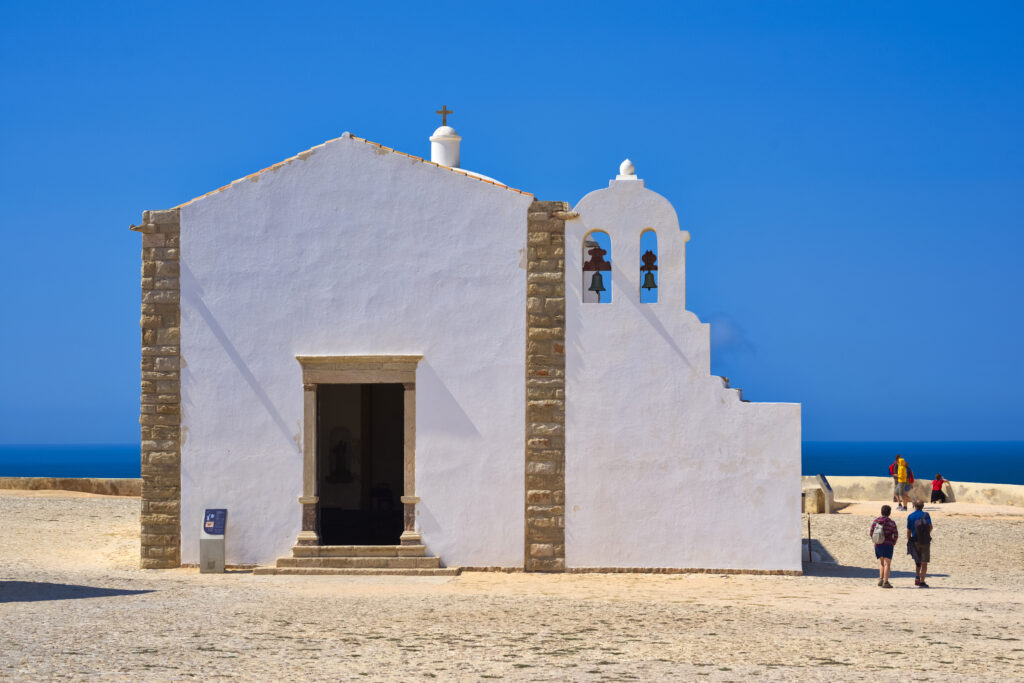
Sagres is the most south-westerly town in Portugal. The nearest major tourist town is Lagos (22 km), Faro airport is 116 km away and Lisbon is 330 km away.
The port town of Sagres is known to many holidaymakers, but primarily because of the Cabo de São Vicente, a cape with a 60-metre-high cliff and an 86-metre-high lighthouse.
The city’s second famous attraction is the Fortaleza de Sagres fortress. This is located on a one-kilometre-long cliff called Ponta de Sagres, around 2 km south of the town itself.
As Sagres does not have a real tourist center, many holidaymakers only come here for a day trip. However, if you like staying overnight with a magnificent view, you should book accommodation high up on the cliffs for a few days.
The rugged coastline, the stormy wind and the roaring Atlantic provide a wonderful contrast to the southern resorts in the Algarve.
What you should definitely do in Sagres is visit the Cabo de São Vicente and the Fortaleza de Sagres. A visit to the beach is also definitely worthwhile here.
Albufeira
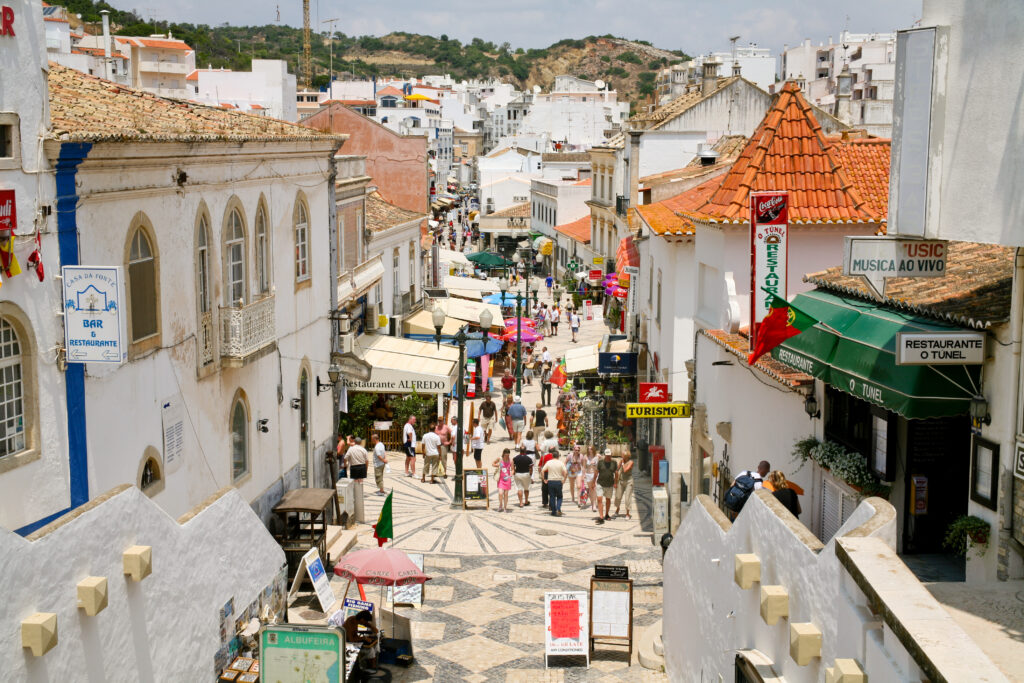
Albufeira is located in the heart of the Algarve. The small town was once a classic fishing village, but has developed over time into an energetic destination for beach vacationers and water sports enthusiasts. Entertainment options aimed at families on the one hand and party fans on the other make Albufeira a lively travel favorite, especially during the high season.
Albufeira is less suitable for culture vultures, as the town has hardly any classic sights. Instead, the town itself is one big must-see. The old town district is the most important starting point for holidaymakers who want to soak up the typical Portuguese flair. In the harbor, on the other hand, a maritime ambience awaits, where you can enjoy a delicious meal or go on exciting boat trips.
In contrast to many other parts of Albufeira, the old town district still has a more tranquil side. Here you will meet locals sitting outside their front doors, chatting comfortably and probably greeting you with a smile. There are also family-friendly cafés, restaurants and stores in the winding, small alleyways.
You can also enjoy Portuguese food around the port of Albufeira. The focus in the many restaurants and cafés is clearly on fresh fish dishes. You can also marvel at the luxury yachts anchored here – the harbor can accommodate up to 500.
Loulé
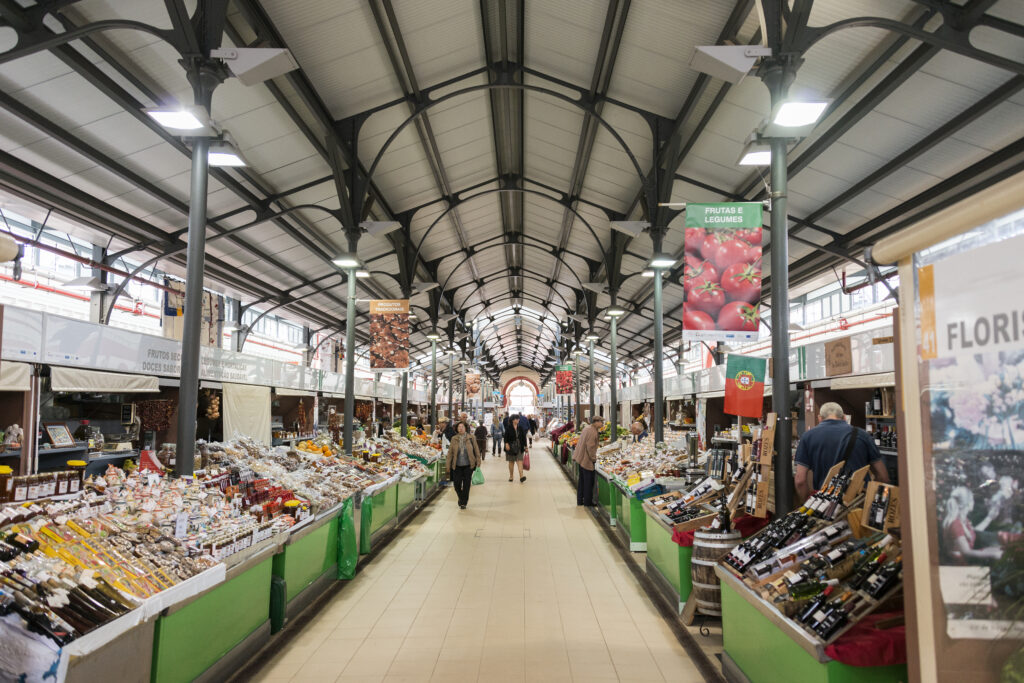
A visit to Loulé is always worthwhile, as the town offers numerous sights, is original, has spacious avenues and squares and is lively. It is located just 15 kilometers north of Faro.
The huge market hall in the city center is very impressive. It is considered the most beautiful in the Algarve and the range of products on offer is huge. Meat, fish, cheese, fruit, vegetables, honey, nuts and many other local products are on offer. On Saturdays, traders also offer their goods outside the market hall.
The old town alleyways leading to the Igreja Matriz de São Clemente, the town’s main church, are also pretty to look at. The origins of the church date back to the 13th century, but it was severely damaged by earthquakes three times and then rebuilt. You should not miss a visit to the high castle walls in the town center. The castle can be climbed via steps and from there you can enjoy the beautiful view over Loulé.
Right next to the castle is the Convento do Espirito Santo, founded in the 17th century, which has been extensively restored and serves as a cultural center with changing exhibitions. Other sights include the small chapel Ermida de Nossa Senhora da Conceicao with its simple façade directly opposite the convent, the old city gate Portas de Ceu and the Igreja da Misericordia.
Silves
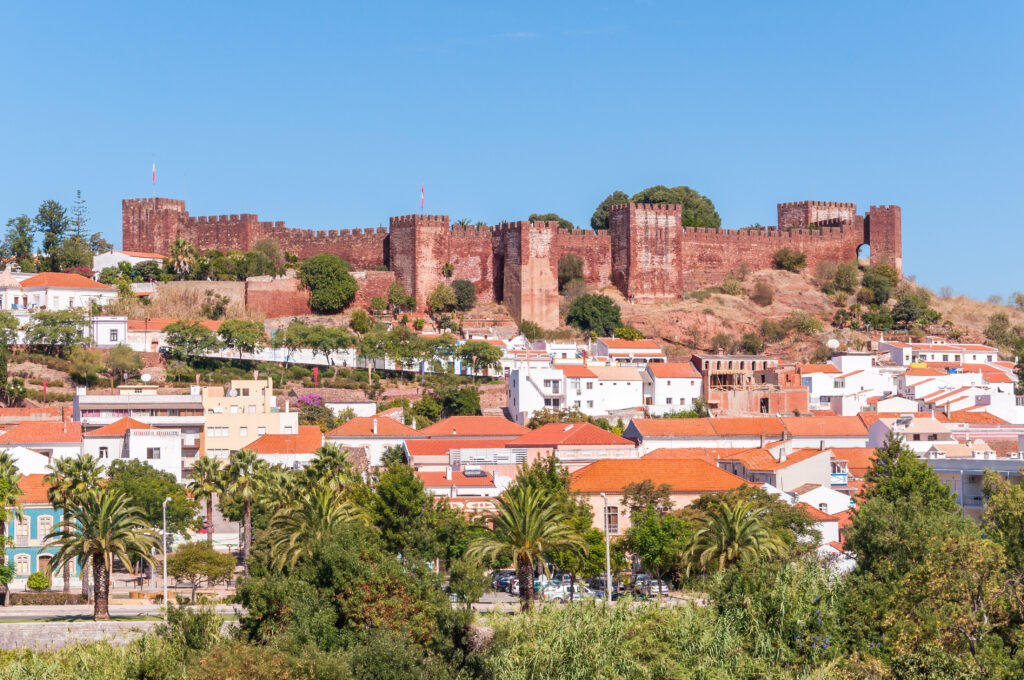
Silves was once the cultural center of the Algarve and the capital of the Moorish “Al-Gharb”. Today, the pretty town in the hinterland of the Portuguese vacation region is more like a sleepy nest. The old “Castelo de Silves” and the “Sé Velha” cathedral, one of the most important churches in the Algarve, are still a reminder of its former power. A visit to the historic walls is not to be missed!
A visit to Silves is not complete without a visit to the castle, which is considered one of the most important and most beautiful Moorish fortresses in Portugal and the largest in the Algarve.
The history of the castle, which was classified as a national monument in 1910, dates back to the time when Silves became a strong occupation base and a commercial center of great prosperity under Roman rule.
Around 716, the Moorish conquest led to enormous changes to the fortress that the Romans had built above the town. The fortress, located on the highest point of the hill on which the city stands, was reinforced by a new wall with towers and armor that extended along the right bank of the river.
The Alcazaba, built on the top of the hill and protected by 11 square towers, houses two cisterns, the Moura and the Cães.
The medina, in turn, was connected to the Alcazaba by a gate protected by two towers.
Alcácer do Sal
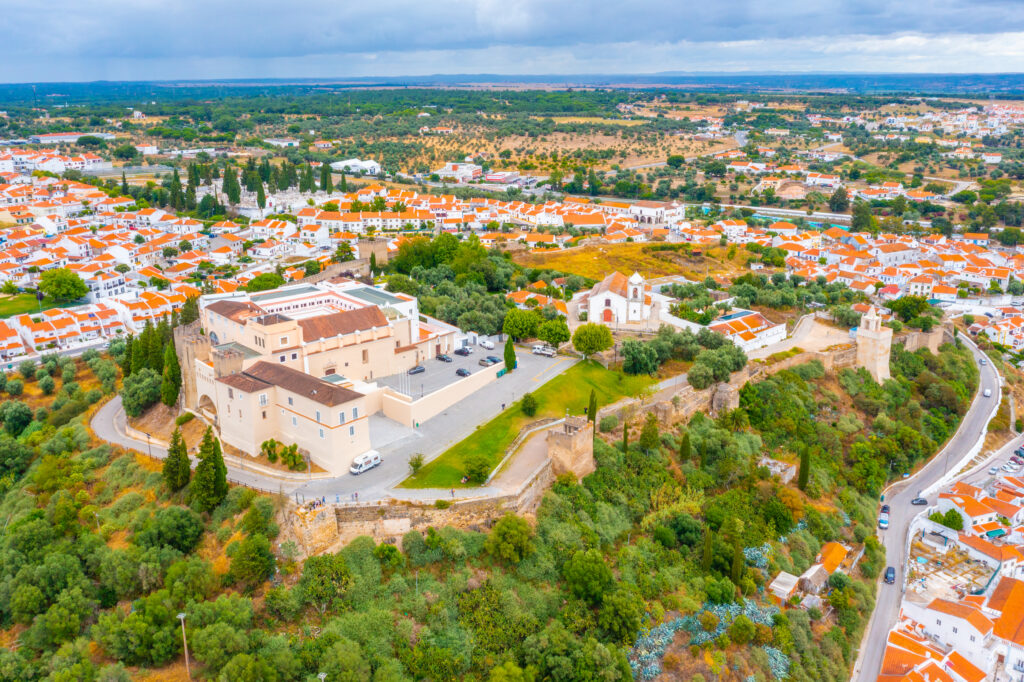
The small town of Alcácer do Sal, gracefully situated on a small hill on the right bank of the River Sado, was inhabited a very long time ago. Archaeological evidence from the Neolithic period bears witness to this. The presence of the Greeks, Phoenicians and other Mediterranean peoples has also been proven.
Although Alcácer do Sal has lost its former military and commercial importance, the town has lost none of its remarkable beauty. From the castle, you can see the curve of the River Sado to the south, surrounded by a gentle green landscape that heralds the vast plains of the Alentejo.
The recently restored castle, which now houses a pousada, bears the name of its Christian conqueror, King Afonso II. From up here, the view sweeps in all four directions over wonderful panoramas of the river and the fields. It is easy to transport yourself back in time and imagine the busy traffic of different goods and people that used to take place in this area.
Don’t miss the opportunity to explore the most beautiful part of the town on foot. The small streets and steps lead up to the castle. Don’t forget to visit the nearby villages of Aldeia de Santa Susana, Porto de Rei, Torrão and the Barragem do Vale do Gaio reservoir or one of the beautiful beaches such as Comporta.
Praia de Rocha
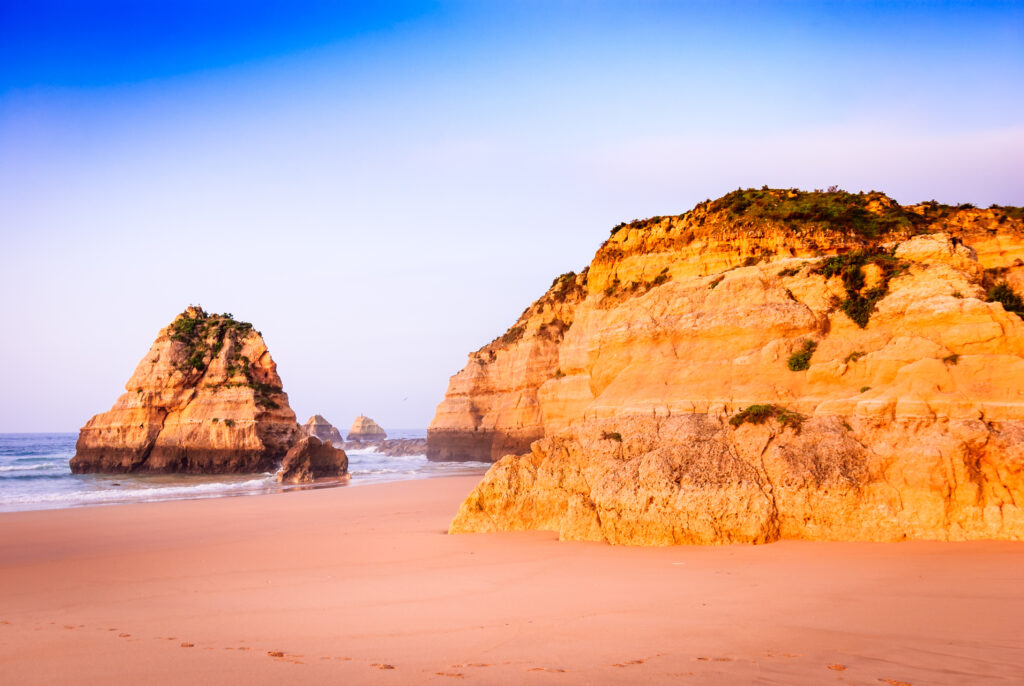
Praia da Rocha is located south of Portimão city center, in a popular vacation resort with many hotels, restaurants and bars. Although the tourist offer mainly attracts package tourists, Praia da Rocha is one of the best beaches in the rocky Algarve.
The beach begins at the mouth of the Rio Arade, right next to the Portimão marina. It is also the widest here. Towards the west, it gradually becomes narrower and ends at highly jagged rock faces in warm colors, which are a popular photo motif. Behind it begins the equally popular Praia dos Três Castelos.
Praia da Rocha offers all the necessary facilities for a relaxing day at the beach. You will find numerous restaurants and cafés on Avenida Tomás Cabreira. Even better are the numerous beach bars, where you can also enjoy excellent food and drink.
When the beach empties out in the evening, the time for night owls slowly begins. Praia da Rocha is a great place to party during the summer months. The bars and clubs are open until the early hours of the morning. There is also a casino here.
In addition to the marina, you should also visit the Santa Catarina fortress, which, like the Miradouro dos Três Castelos, is a great vantage point.
Vilamoura
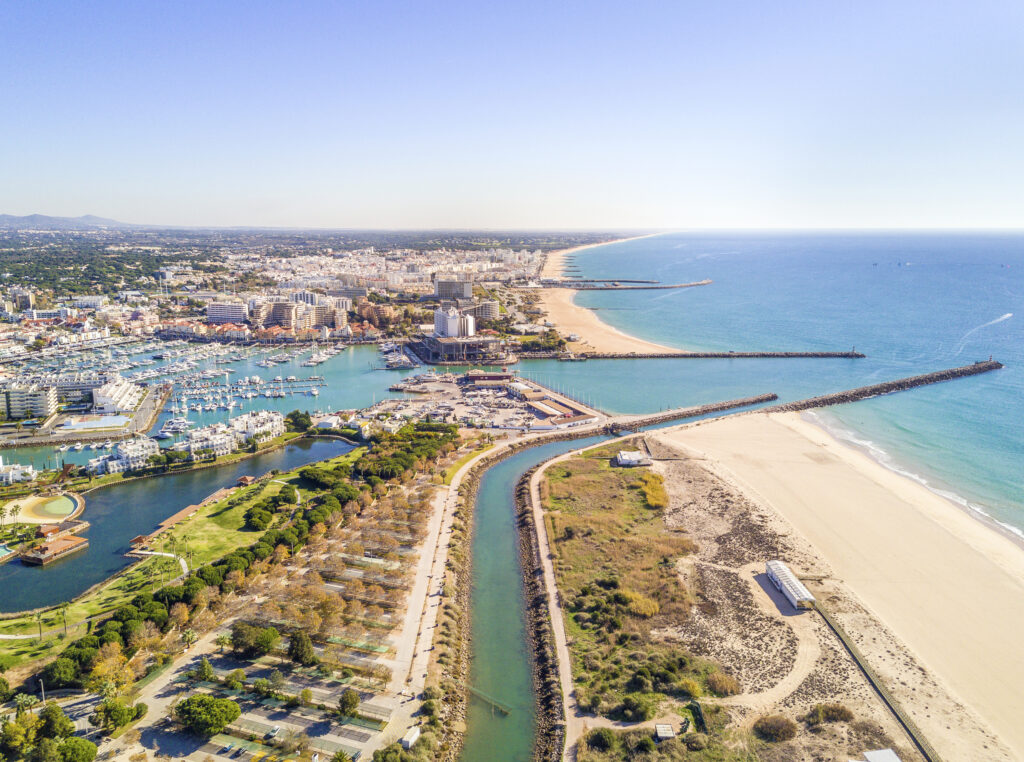
Vilamoura is located in the municipality of Quarteira, right on the coast. Together with the neighboring resorts of Vale do Lobo and Quinta do Lago, Vilamoura forms the so-called “Golden Triangle” of the Algarve.
The town beach of Vilamoura, in the immediate vicinity of the marina, stretches as far as the fishing port of the neighboring town of Quarteira. The long sandy beach is wide and shallow and offers numerous water sports facilities.
On the other side of the entrance to the marina are two more kilometers of sandy beaches. The small river Ribeira de Quarteira flows out here. From the cliffs here you can hike along the beach to Pine Cliffs in the district of Albufeira.
The region around Vilamoura is a paradise for golfers: there are six golf courses in the resort alone and seven more in Quinta do Lago and Vale do Lobo. International tournaments such as the Portugal Open or the Portugal Masters have often been held here.
The ideal starting point for a variety of water sports activities is the Vilamoura marina. Boat trips along the coast to the cliffs and caves near Albufeira are offered here, as well as dolphin watching trips and deep-sea fishing.
The market hall at the fishing port of Quarteira is considered one of the best places in the world to buy freshly caught fish and seafood. On Saturdays, farmers from the surrounding area and the Alentejo offer their regional produce here – an ideal opportunity to find out more about the country and its people.
Lagos
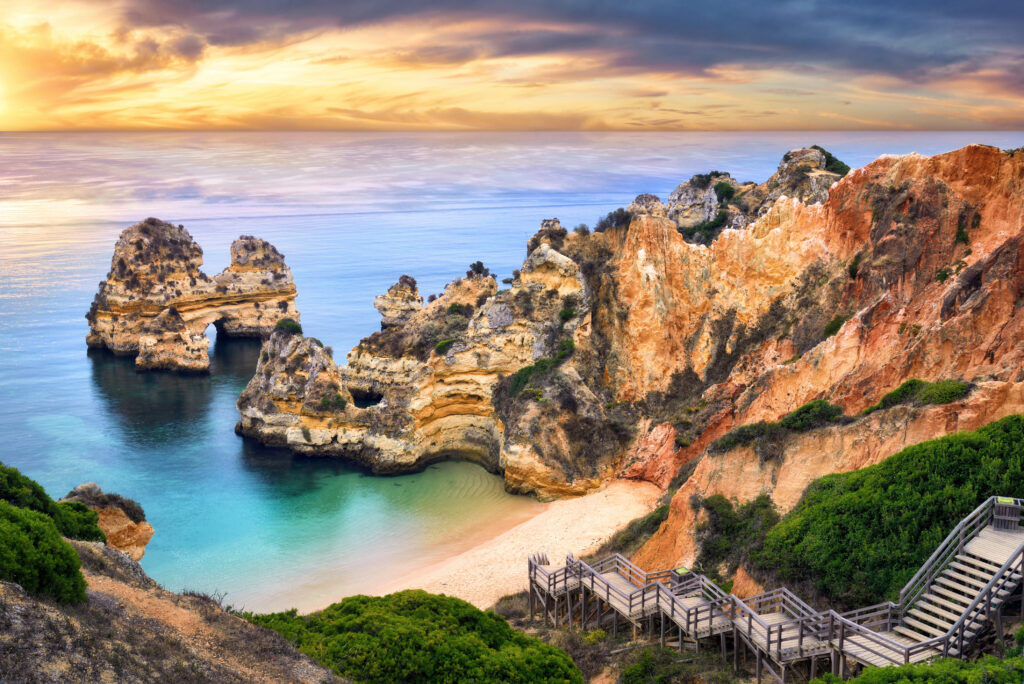
The city of Lagos is one of the most beautiful cities in the Algarve. The choice of impressive beaches is enormous. To the east of the city, a kilometer-long wide sandy beach – Meia Praia – stretches along an impressive bay, while to the south and west you will find the most beautiful rock formations in the Algarve, including small, cozy rocky coves.
The old town center of Lagos, with its pedestrian zone and many small and large squares, has been very well preserved. Many buildings have been partially restored and refurbished and the squares and alleyways still feature calçadas (cobblestones) laid in motifs and patterns. The many typical Portuguese stores and restaurants are well worth a visit.
The lively square Praça Gil Eanes forms the center. The idyllic square is surrounded by jacaranda trees, which bloom in an indescribable blue in spring. From here, many small and larger alleyways branch off to other squares, where cozy cafés and restaurants lined with orange trees await guests.
At the entrance to the port of Lagos, the Lagos Fort, which now houses a museum, is located on the wide paths. It describes the individual countries that were discovered and conquered by the Portuguese sailors. The climb to the battlements is particularly worthwhile, as there is a beautiful view over the harbor and the city from the top.
Alvor
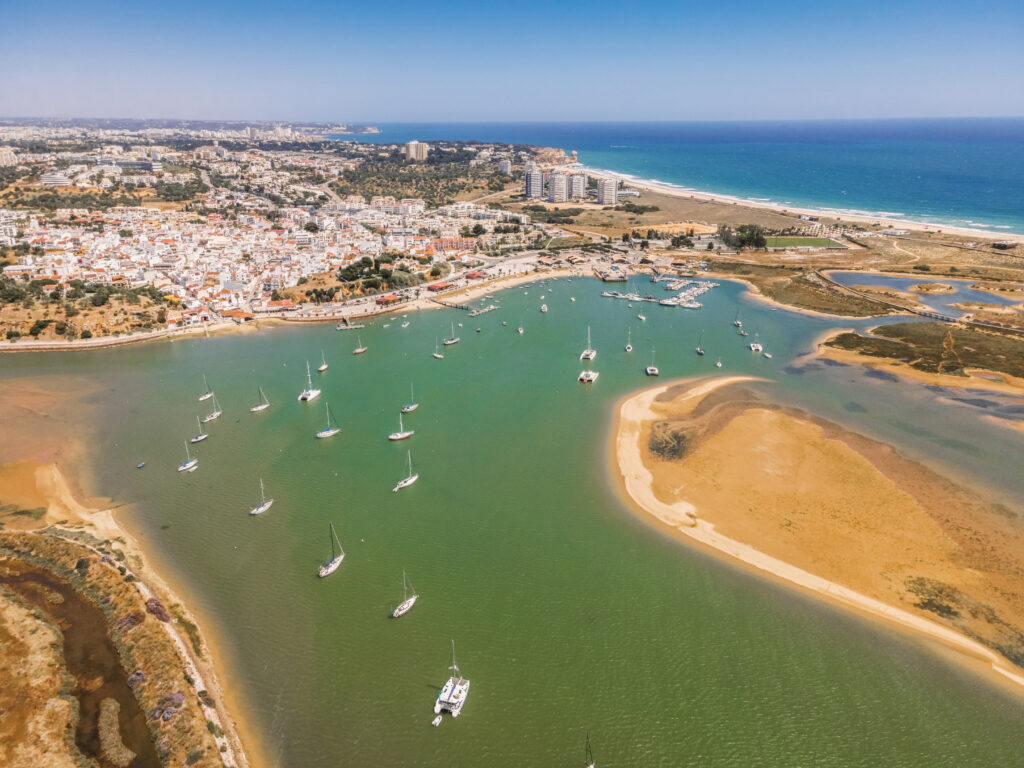
In Alvor, you have the opportunity to get to know Portugal from its original side. The village, with around 5,000 inhabitants, is located between Lagos and Portimão in the rocky Algarve. To the west of the town is a lagoon into which the river Rio de Alvor flows.
The coast of the Atlantic Ocean is around one kilometer from the town center as the crow flies. This is the reason why Alvor has so far been spared sprawling hotel complexes and apartment complexes. Most people who spend their vacation on this stretch of coast opt for a vacation apartment or a vacation home in Portugal as their accommodation.
The town center has retained its original appearance, even though Alvor has a well-developed tourist infrastructure. The narrow streets are lined with houses with snow-white façades. Fish dishes and seafood are served in the numerous restaurants.
Bream, sole, mussels and squid are prepared freshly caught as soon as the fishermen return with their boats. The colorful fishing boats on the beach of the lagoon underline the original charm of this vacation resort in the Algarve.
The rocky Algarve stretches between the city of Faro in the east and the windswept south-western tip of the European continent, Cabo de São Vicente, in the west. Alvor is centrally located on this stretch of coast.
Carvoeiro
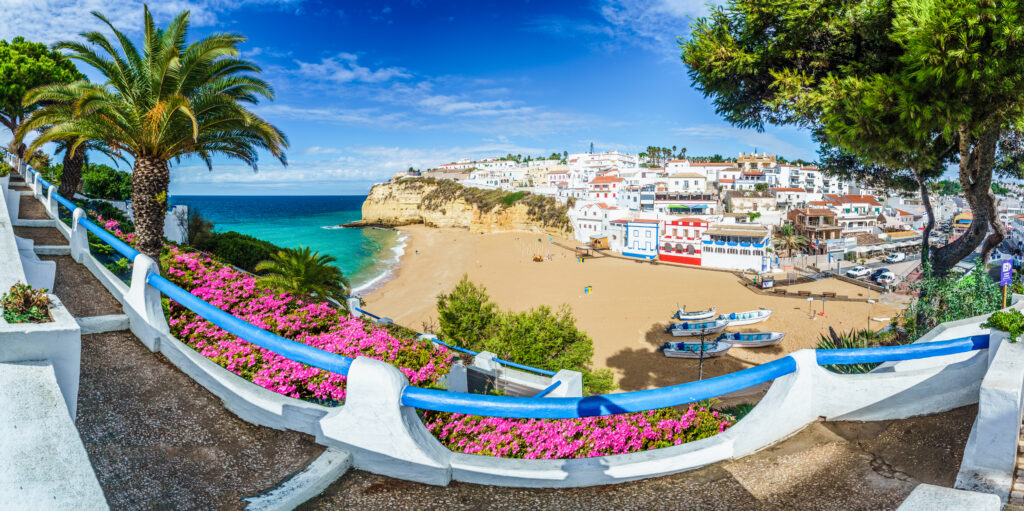
The former small fishing village of Carvoeiro is today a typical idyllic town in the Algarve that has enchanted countless sun-seekers. The first to succumb to its charm were rich Portuguese from the north who could afford to build their vacation homes here on the western slope of the village bay, which they lived in during the summer months.
Carvoeiro has now developed into a popular vacation resort. This is certainly primarily due to the fact that, thanks to sensible construction planning by the district administration in Lagoa, the village is “free of high-rise buildings”. The vacation resorts that have sprung up around the actual village center have been built in a style adapted to the landscape and can therefore easily be described as a villa resort.
In addition, beautiful sections of the rocky Algarve, such as the “Algar Seco”, can be found in the immediate vicinity.
The access road to Carvoeiro ends at the main square and town center. To the left and right, the square is picturesquely framed by the rising rocky coast. In summer, music is played on a small stage here in the evenings and people meet in the numerous cafés and restaurants.
The only church in the village can be reached from the square. From the square in front of the church, you can enjoy the wonderful view of the bay and the village itself or the Atlantic Ocean as far as Portimao or Lagos. The sunset in the evening is particularly impressive and spectacular.
Praia de Luz
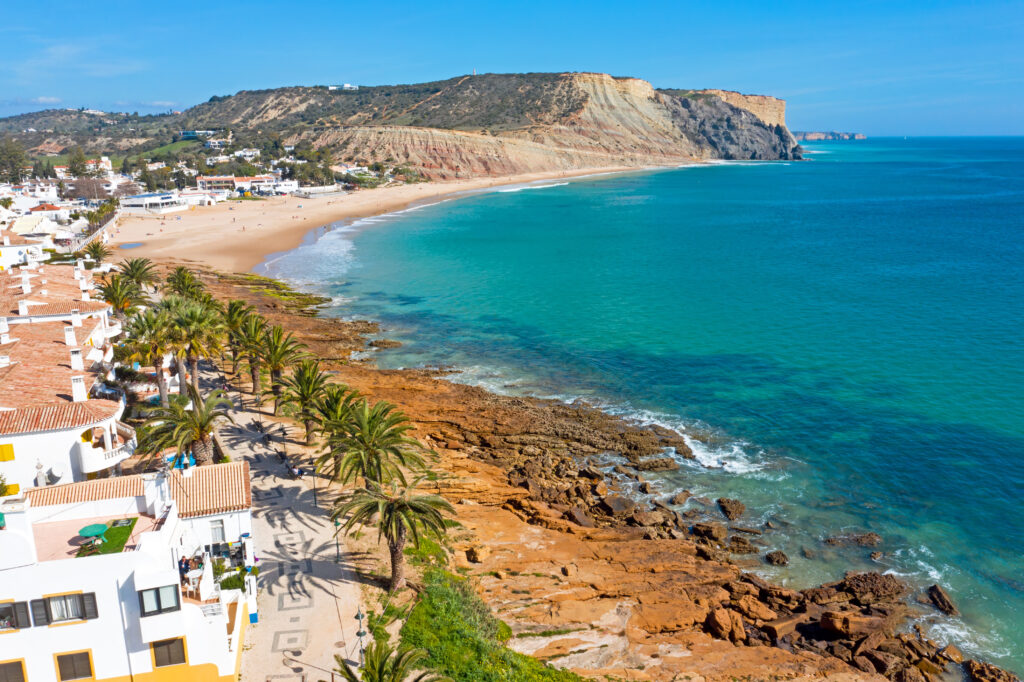
Luz is an idyllic little seaside resort situated around a beautiful bay with a sandy beach. This is why the locals call it Praia da Luz, the beach of light.
The small town benefits from the cultural and vibrant attraction of Lagos, but still has its own charm. Here you will find an unbelievable variety of small and large properties surrounded by mature gardens.
The beautiful beach promenade with its typical Portuguese pavement is particularly inviting for strolling and relaxing. From here you have a fantastic view of the bay and the beach with its famous black volcanic rock.
It is only a 5-minute drive to Lagos and a 20-minute drive to the impressive rugged beaches of the west coast, making it an ideal vacation home.
Due to the very pleasant temperatures in winter and the sheltered location within the bay, Praia da Luz has become more and more of an insider’s tip for wintering holidaymakers. Praia da Luz, the “beach of light”, lives up to its name, especially in winter. Nowhere else can you find such a bright, radiant light as in this place. Especially in winter, this is very pleasant for the soul.
Cabanas
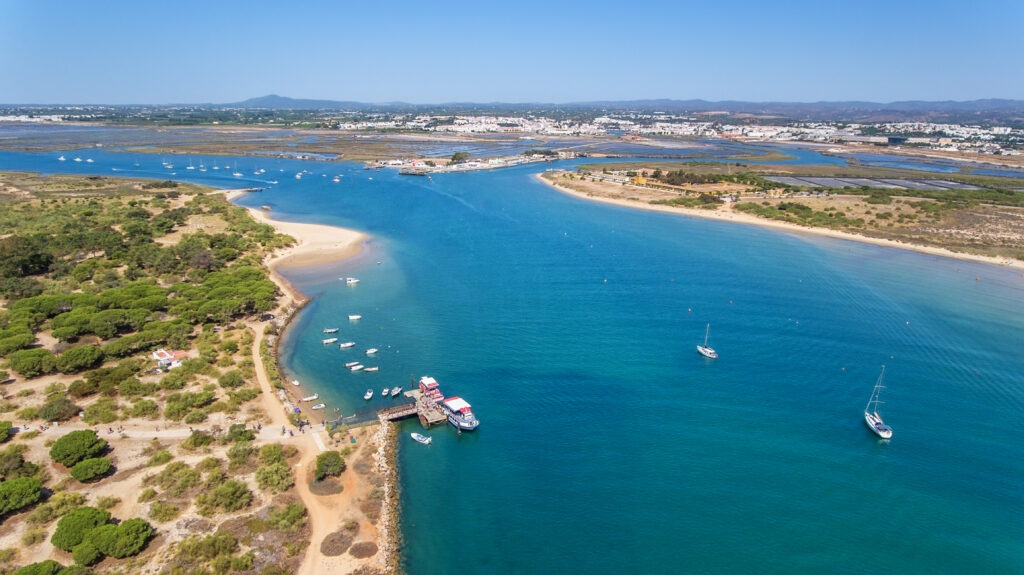
Once a sleepy fishing village, now a popular resort, Cabanas lies on a lagoon a short drive east of Tavira at the gateway to the Ria Formosa Natural Reserve. The Avenida Ria Formosa promenade runs along the seafront here and features a number of small shops, cafes and restaurants. On the seaward side of the promenade is an attractive new boardwalk which runs along the entire length of the lagoon.
Just across the waters is the long, white sand Ilha de Cabanas island beach, which can be accessed by ferry or water-taxi. The waters on the island beach are crystal clear and good for a refreshing dip. Because it is that bit harder to access this beach doesn’t get as busy as most on the Algarve, even in peak season.
The resort gets its name from the traditional cabanas fishing huts, which started to be built here in 18th century to store the tackle of the fishermen who once fished for tuna here. Some attractive fishermen’s cottages are still to be found in the older part of the village.
Today tourism has overtaken fishing as the main industry here, although there are still plenty of small fishing boats to be seen along the seafront. The village has undergone significant development in the last decade, and gets quite busy in July and August, but this said, it retains plenty of charm.
Tavira
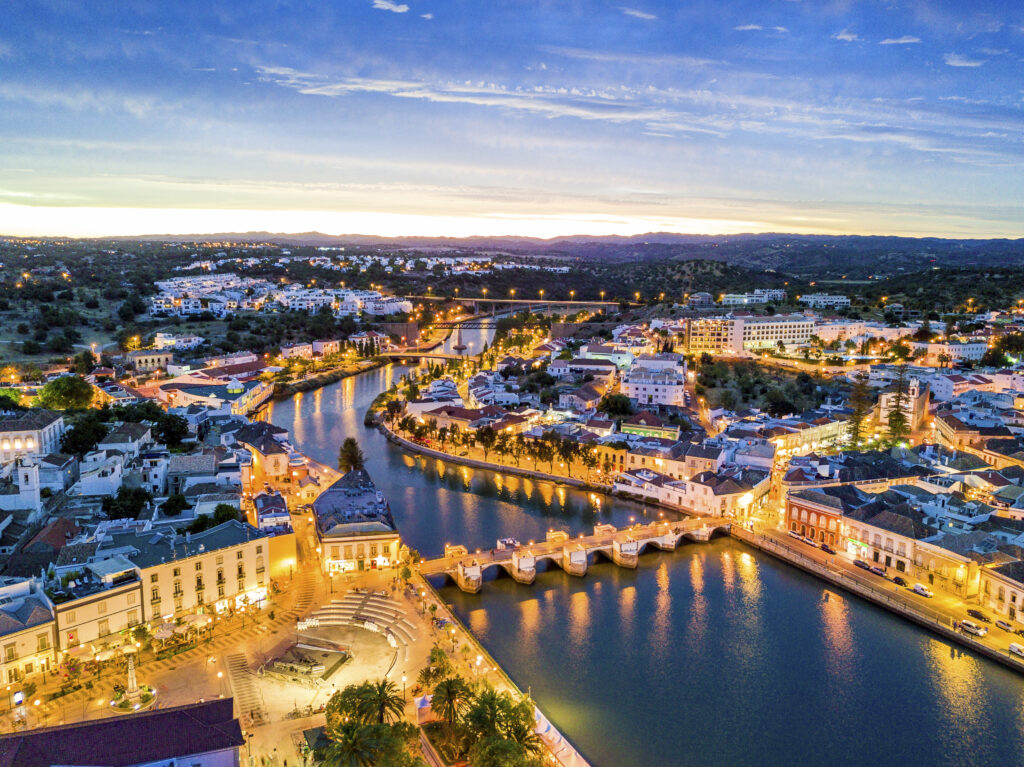
Tavira is considered one of the most beautiful towns in Portugal. The small harbor town is located on the leeward side of the Algarve. Tavira looks back on thousands of years of history, the cultural and architectural traces of which are clearly visible in every part of the town. Remains of ancient settlers, medieval ruins, Gothic churches and Moorish-inspired, tiled houses characterize the cityscape.
Visible from all sides, the ruins of a castle on a hill tower over Tavira. The fortress was once built by the Moors and further extended in the 13th century. Today, the walls house a flourishing garden. The view over the battlements reveals the diverse architectural composition of the town.
The towers of Tavira’s 37 churches rise up between the sea of hipped roofs, many of them ornately decorated. In the center of Tavira, the seven-arched Roman bridge spans the Rio Gilão and leads to the Praça da República, Tavira’s central square in the old town. White and blue tiled house facades rise up between small cafés and restaurants.
The so-called azulejos are intended to protect the facades from heat and moisture and were originally introduced to Portugal by the Moors. From the city center, a multitude of small alleyways lead visitors into the remote squares of Tavira’s historic old town.

